What if you could read your audience’s mind?
You could create the products your customers need, improve your profits, and save many hours. You’d become the creator or brand that just “gets it.”
Ding, ding, ding! Your wish is granted. 🧞
There is a way to keep your pulse on the market and proactively anticipate what your audience wants — through social listening.
What is social listening?
Social listening is observing what your audience is saying about your brand and industry online to understand their needs.
Let’s say you’re a skincare company. You want to launch a new product but have no idea what your audience is struggling with. Along with interviewing your current customers, you join a bunch of niche communities around skincare on Reddit, Facebook, and Discord and learn a lot of your target customers are battling adult acne. Now, you know you should launch a product targeting this issue.
👆That is social listening in action.
You listened to your audience — including (both) current and prospective customers — and made a data-informed decision.
Social media monitoring vs. social media listening: Is there a difference?
Social media monitoring and social media listening are often clubbed together under digital marketing. But they aren’t synonyms.
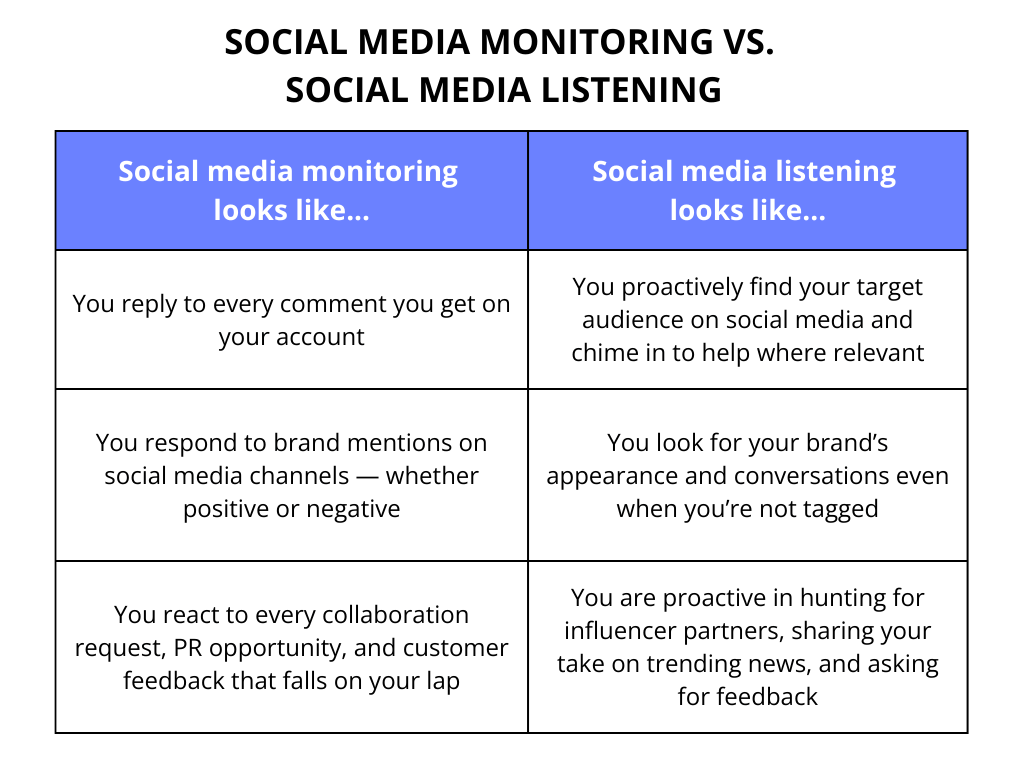
The differences are somewhat clear, but it’s still muddy waters. Some articles will say social media monitoring is proactive while listening is reactive. Another will mention how monitoring attacks the “how” while social media listening attacks the “why.”
All of these statements are true, but there are always exceptions.
- For example, monitoring your brand’s reviews on third-party seller sites is both proactive and reactive.
- Similarly, even while grazing through your social media comments, you might notice how multiple comments on your account highlight the same issue and wonder “why” alongside “how.”
Our take is that brand monitoring is a part of social listening. The latter encompasses any kind of listening you do — whether it’s proactive or reactive, whether it’s questioning how or why.
(The intermingling of the two concepts is also why many social media monitoring tools contain plenty of social media listening features.)
Cassey Ho Vinh, CEO and Founder of Blogilates, is an excellent example of how to do both simultaneously.
She saw a relevant creator in the fashion industry talk about the troubles she faces with hoodies. Vinh did some sentiment analysis and found many of her target audience members also feel the same way. So she applied social listening and made a product — a new hoodie — with all the features the market wanted.
Soon, Vinh got customer feedback on that same product via social media monitoring: People wanted hoodies without zippers. So, she made a hoodie without zippers.
Vinh is a pro on how social media monitoring and social media listening work in tandem. After all, both have the same goal — delighting your audience.
Why practice social listening: 5 major benefits
Why go to the lengths of taking charge when you can make do with social media monitoring? Here are five reasons why social listening should be a non-negotiable part of your social media marketing strategy.
1: Social listening helps you understand customer sentiment
It’s hard to get genuine and detailed feedback from customers. Interviewing your audience in-depth is also a time-consuming endeavor. Not to mention: It’s hard to do at scale.
Social media listening enables you to go out there and get your hands dirty without these limitations. You can be a bystander to online conversations and pick up on something valuable.
Take Ian Evans, content creator at tl;dv. He creates social media content around jobs he’s never done himself. How? By learning from memes, comments, and his network, according to his LinkedIn post.
This TikTok video, for example, originated from a meme. Evans knew developers get mad when their code fails to run. Witnessing the meme made him understand why that’s funny. The post got over 100 likes, comments, and shares.
@tldv.io Imagine if your code could talk … #productmanagement #developer #tech #startup #corporatehumor #aitools ♬ original sound - tldv.io - AI Meeting Recorder
Through social listening, Evans could pick up on a latent customer sentiment and optimize it for entertaining content. It proves how social listening data can direct your marketing campaigns and solidify your content strategy.
And social listening isn’t limited to content creation. It can evolve into tangible product developments, too. Tl;dv launched on Microsoft Teams right at the cusp of when people started asking about the feature’s launch date.
Social listening can come to your aid — whether it’s for creating relevant content or launching much-needed features. Both of which ultimately boost the customer experience.
2: Social listening boosts your reach
Social listening means you’re on top of the latest industry trends. You know what’s happening in your niche, which types of social media posts are getting more engagement, and what people are saying about you in real time.
And when you leverage trends, you increase your reach on all social media platforms. For example, budgeting app YNAB used a classic meme format when they learned their competitor, Mint, was shutting down.
Not only did this post get over 2000 likes in 14 hours — boosting their Instagram reach — but it also helped them shine as an alternative for all the Mint users.
It isn’t the first time YNAB has used trending memes to increase engagement. They frequently use popular dialogues from pop culture — like Gilmore Girls, Mean Girls, The Office, and Modern Family — in the context of relatable financial struggles.
Hopping on trends and making them your own is the easiest way to grow on social media. Social listening ensures you know those trends at the right time.
3: Social listening enables solving buyers’ objections pre-purchase
Imagine if you could resolve the friction point for a prospective buyer before they got a chance to complain. Your brand reputation would elevate instantly, and you’d start customer relationships on the right note.
For example, Dave from our team saw a tweet asking for a tool to repost his content on Twitter onto other social media platforms. Using social listening at its finest, he jumped in and pitched Buffer.
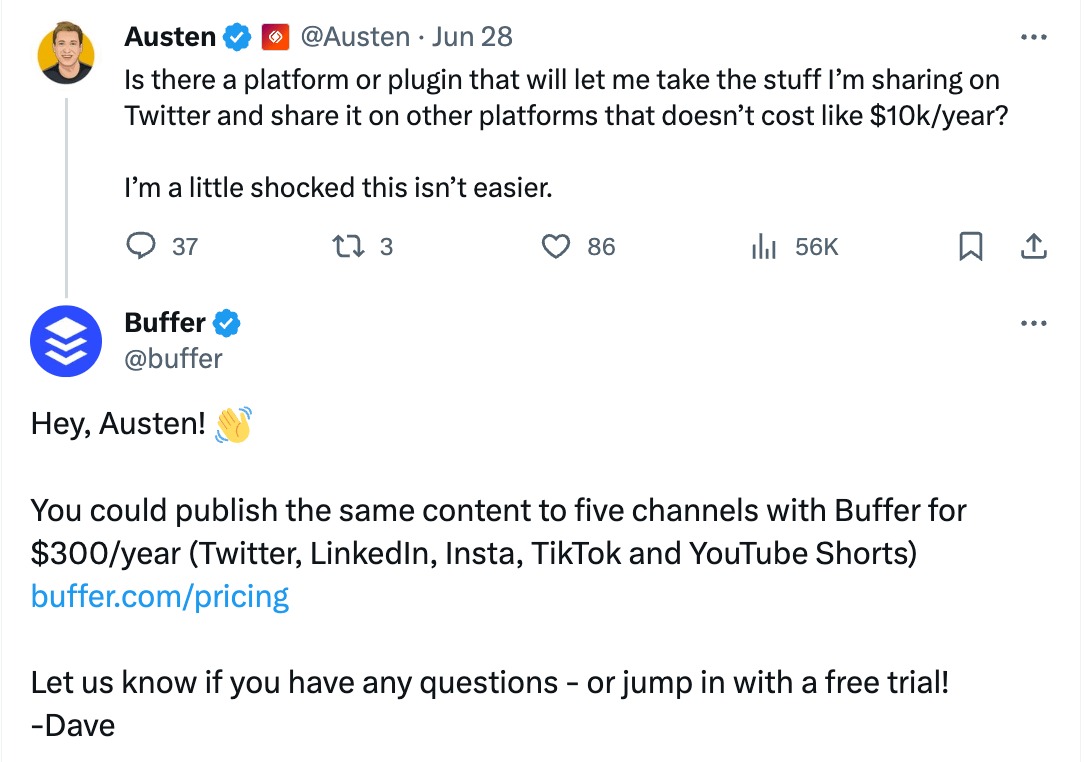
If you know your buyers’ problems, hunt for them on social media and pitch your product or service as the solution. Or, if you notice people are complaining about an important feature missing from your competitors’ product (that you have), enter the conversation and let people know your solution as an alternative.
It can also go the other way: If you notice negative sentiment from potential customers in social conversation, you can tackle it effectively. Social listening pushes you to have a crisis management plan in place before things go downhill.
4: Social listening helps you snoop on your competitors’ weaknesses
When you’re aware of what’s going on in your industry, you know your strengths and your competitors’ weaknesses. Social listening improves your competitive analysis — enabling you to highlight your advantages to win over your rivals’ audience.
Take us. When Hootsuite announced the extinction of its free plan, we were quick to share our take.
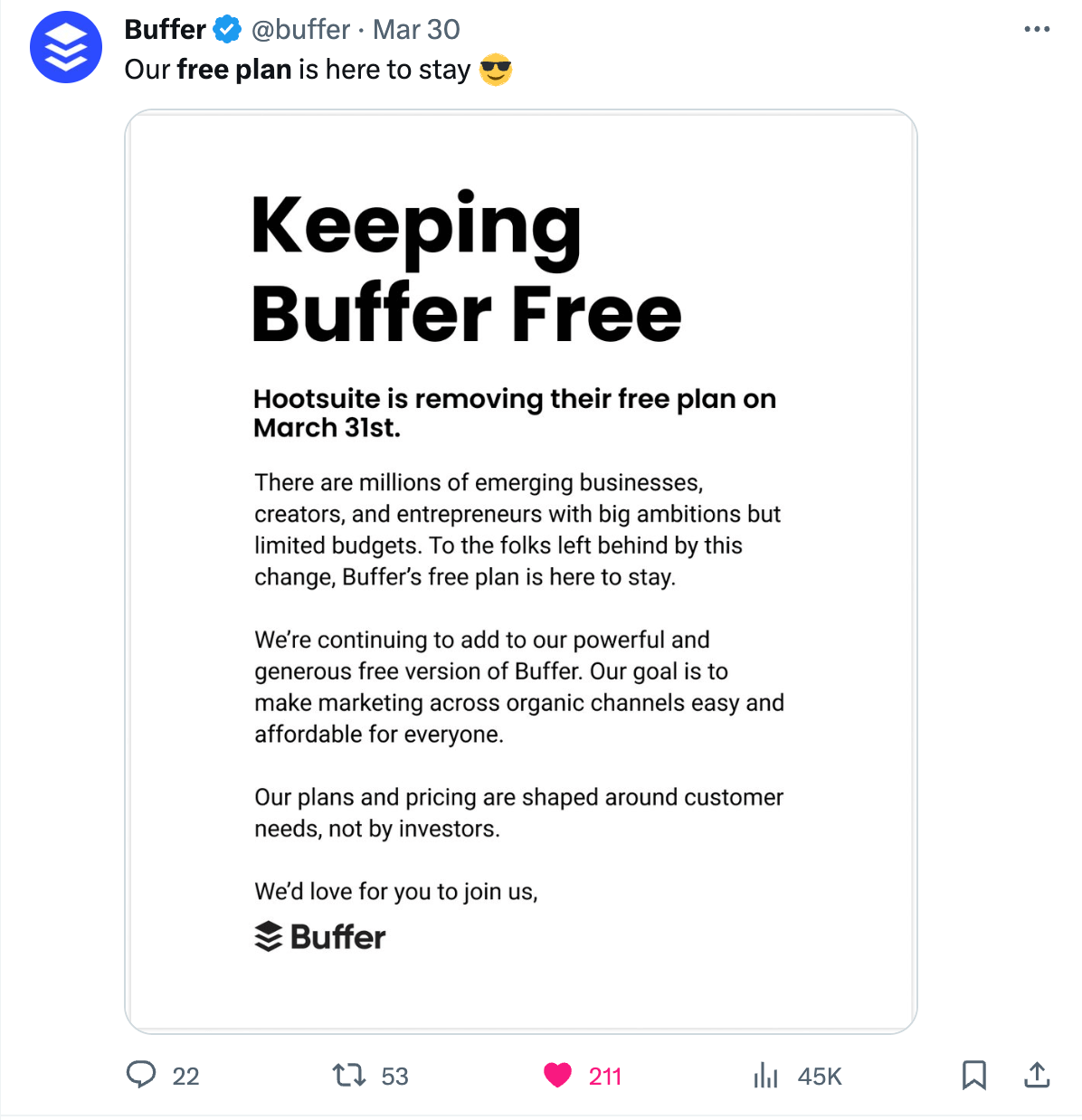
Having an ear on the market helps you understand what you have that your competitors don’t and make that your selling advantage.
5: Social listening can aid in finding key thought leaders and influencers in your industry
Every industry has influential people. Partnering with these thought leaders helps you get in front of a new audience with the creator’s borrowed seal of trust.
And social listening makes it easy to run into these people — especially if they aren’t household names — but small & influential micro-influencers.
Hair brand Shaz & Kiks sends relevant creators their products as gifts. The influencers post it in their Instagram Stories often, like Victoria did — increasing the brand’s online presence and laying the groundwork for a potential collaboration.
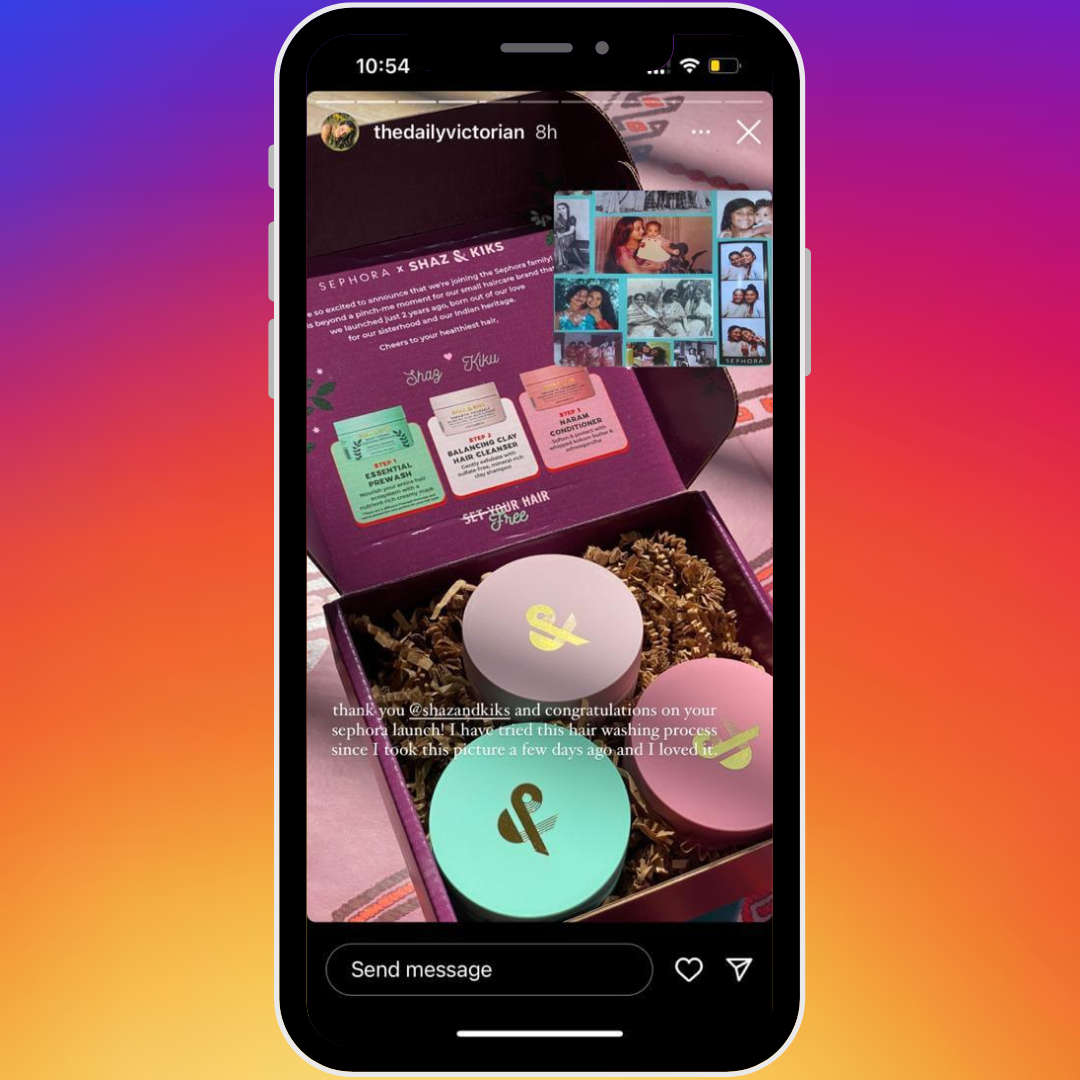
Social listening is a fertile ground for influencer marketing because it helps you stumble across the best creators in your industry organically.
How to shape your social listening strategy in 3 steps
The benefits are all well and good, but what happens when you actually step into the messy grounds of social media to practice social listening? It can be daunting to figure out how to navigate the wild landscape.
Here’s how you can form a clear social listening strategy in three steps:
Step 1: Decide how you will use the insights you uncover
The first step for achieving any goal is figuring out your why. Knowing why you want to practice social listening — and how it can contribute to your business goals — will help you understand the actionable insights you should look for.
And you don’t have to be limited to one aim, but you have to set priorities. For example:
- Your primary goal with social listening can be understanding customer sentiment. Maybe you’re still in the early stages of building your business and would like to understand what customers in your industry truly lack. Your core aim is set. Your secondary goal can be to analyze your potential competitors to find your unique selling proposition.
- Or your primary goal can be to drum up your business engagement to get more customers. Your secondary goal might be partnering with influencers in the space to elevate your first goal.
The steps you need to take for both those goals will differ.
- In the first example, you don’t need to have an online presence yourself. You can be a silent observer and build in the background based on the insights you acquire.
- But in the second example, your approach has to be different. You must participate in online conversations, connect with thought leaders on DMs, and be visible on social media.
Your social listening strategy will depend on how you plan to use the insights you receive from the process. Deciphering that should be your first step.
Step 2: Make a game plan for finding trends & conversations
There are a plethora of ways to find trends and conversations surrounding your brand & industry. We can primarily divide it into two methods:
- Manual: You use the built-in capabilities of social media to monitor conversations.
- Automated: You use a specific software to uncover the trends in your industry.
Ideally, you’d have a mix of both methods in your workflow. Automating tracking mentions of your brand and specific industry keywords isn’t going the extra mile. You must be on the ground and do some grunt work to uncover precious insights.
5 manual ways of practicing social listening
1. Spot influencers using your product.
Keep an eye on your customer list and see who’s purchasing from you. If you spot a well-known celebrity or influencer sporting your product, leverage it on your social channels. A Vintage Fit often shares pictures of popular creators wearing their clothes.
But ensure the celebrity or the influencer is relevant to your customer personas and caters to your ideal demographics.
2. Do an advanced search on Twitter
Twitter’s advanced searching features are a goldmine for market research when you know how to use them right.
You can search for relevant keywords from certain accounts and filter based on engagement metrics. It’s the place to be if you want to stay in the loop of the latest trends, hop on conversations, and connect with relevant influencers in your industry.
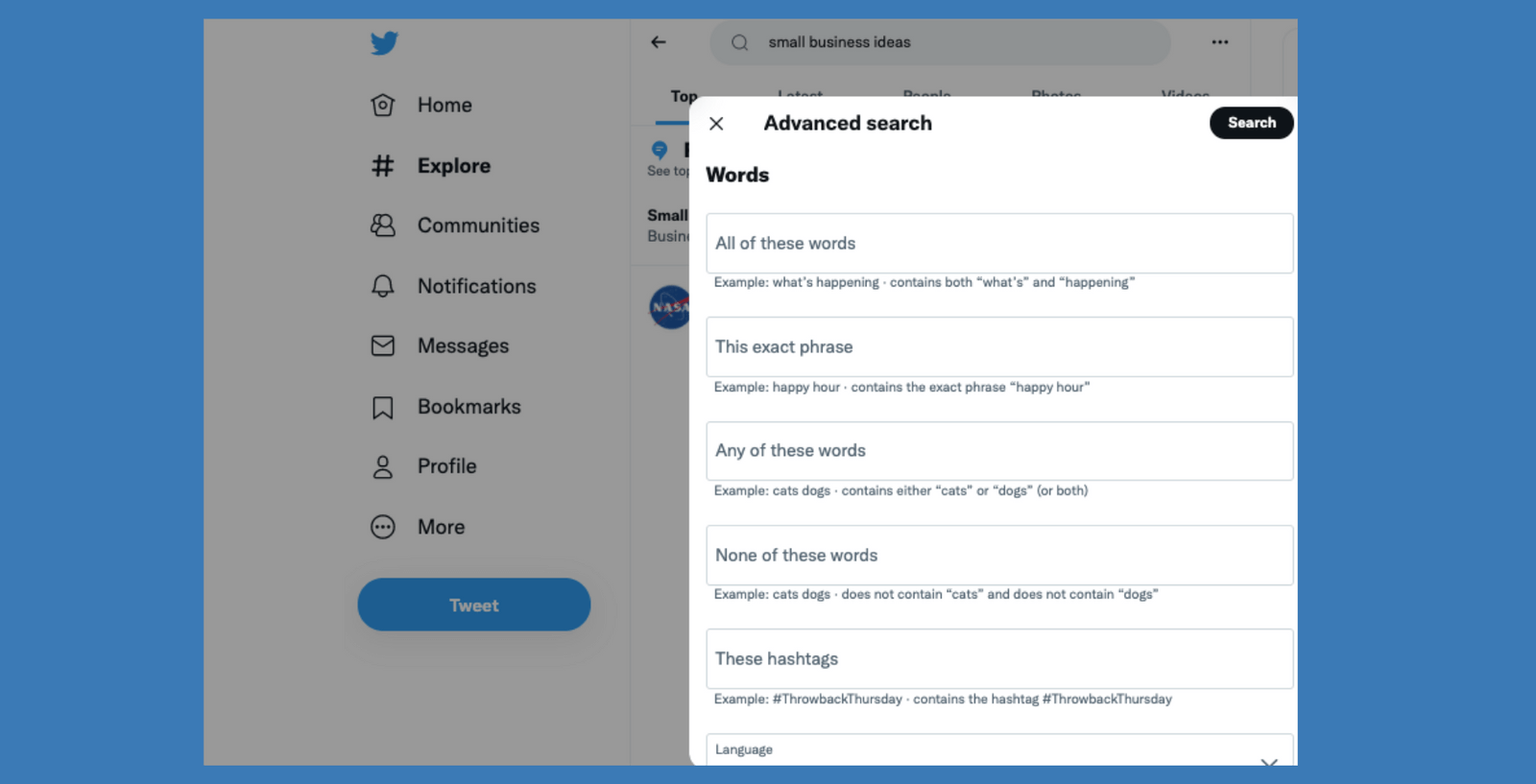
💡 Learn more: The Superhuman Guide to Twitter Advanced Search
If your audience’s choice of social network is YouTube or Instagram, both of them also have excellent search engine capabilities. It’s not as specific as Twitter, but it’s ideal for seeing what other people are saying on a topic.
Or you can set up Google Alerts for industry-related keywords and stay updated on relevant conversations.
3. Search for industry-related hashtags on social media
Making the most of hashtags — whether on Instagram, TikTok, or Twitter — isn’t solely about using them in your posts; it’s also about searching for them to stay updated on the latest news in your industry.
Let’s say you’re a content creator in the productivity space. Use hashtags like #productivity, #productivitymethods, and #productivityhacks to discover the latest and popular conversations around the topic. TikTok even suggests keywords “others searched for” to make your job even easier.
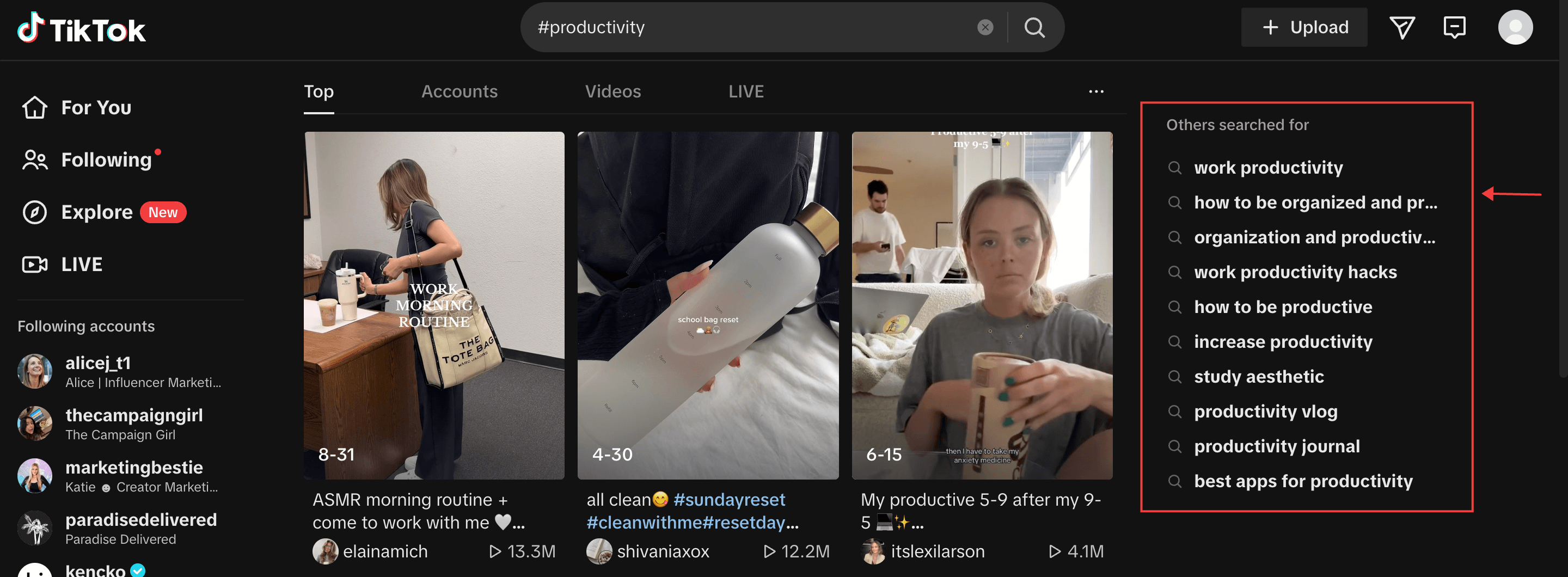
4. Discover what’s trending on each social media platform
Social networks have built features to help creators and small business owners learn what’s trending.
- You can find the trending hashtags on Twitter in the “What’s happening” section on the right-hand side.
- TikTok has a creative center for browsing what’s trending in your country.
Instagram’s @creators account regularly releases a Reels Trends Report.
All of these features are in place for you to spot trends and be a part of the conversation.
5. Join communities
For social listening, you don’t need to build your own community. You can join existing ones. One Google search can lead you to hundreds (if not thousands!) of niche forums in your industry. They can be Slack channels, Facebook Groups, or Reddit threads.
For example, a member of the Pretty Little Marketers Facebook Group recently inquired about whether or not he should purchase a particular camera to shoot social media content. If someone from the brand or a competing company was already a part of this Group, they could take advantage of the opportunity.
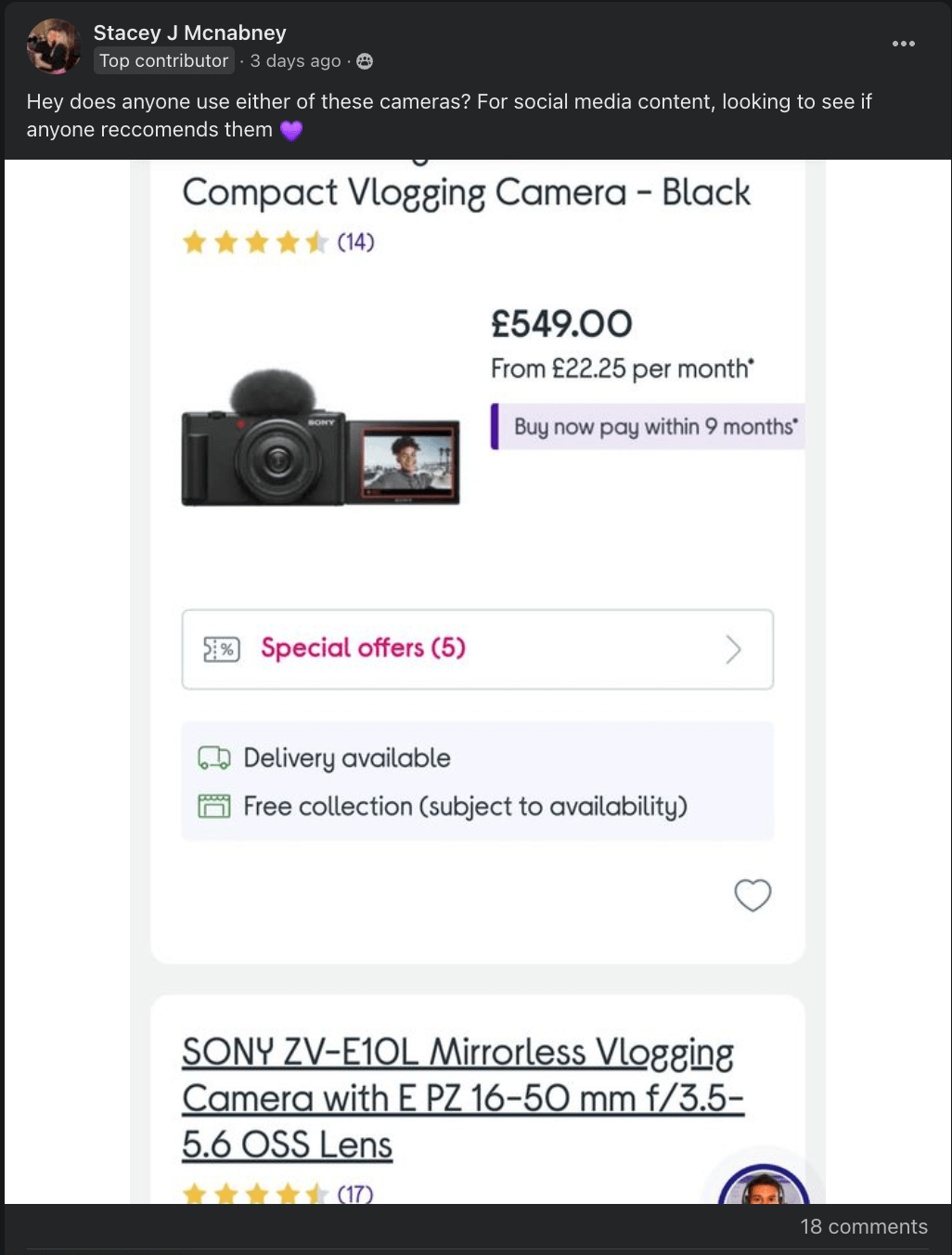
It’s necessary to remember that almost all manual methods for social listening are time-consuming and challenging to scale. You need to have an eye on the market and do as much as possible, but you also need to bring in more efficient methods of tracking industry & brand conversations.
5 social listening tools for practicing automated social listening
1. Buffer
Buffer lets you reply to all your social media comments from the comfort of your desktop. Interacting with the audience you already have is a crucial aspect of social listening. Use Buffer to communicate with your followers and keep them engaged. The best part? You can do a lot more with Buffer — like scheduling posts and tracking their performance — for free.
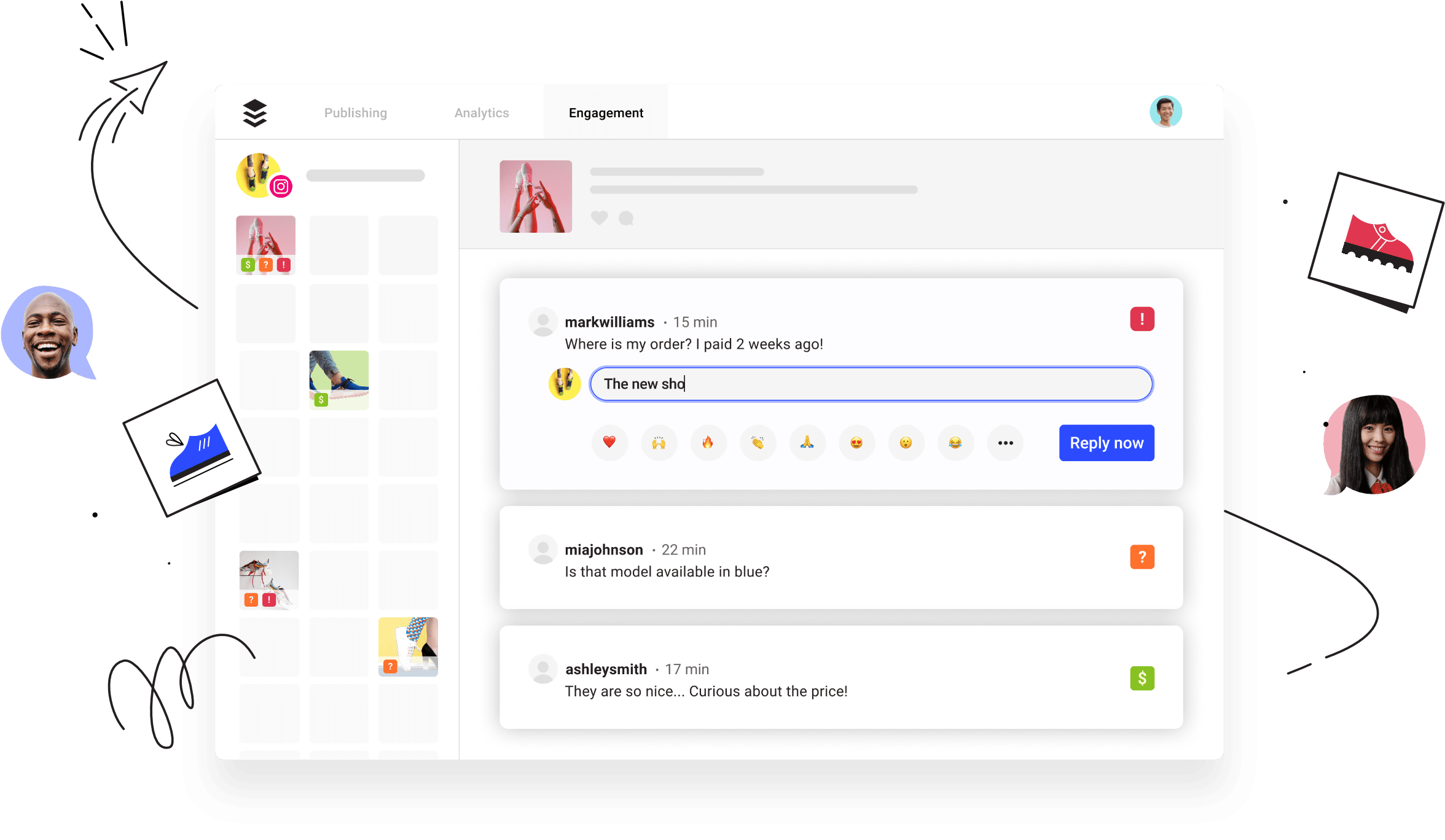
2. Keyhole
Keyhole has a social media listening suite specifically catering to social media listening. You can track mentions of your brand, hashtags, keywords, and influencers. It has a QuickTrends feature, like Google Trends for social media. But it’s an advanced social listening tool priced at $79/month. Purchase it when you have the budget and have exhausted all other ways of social listening.
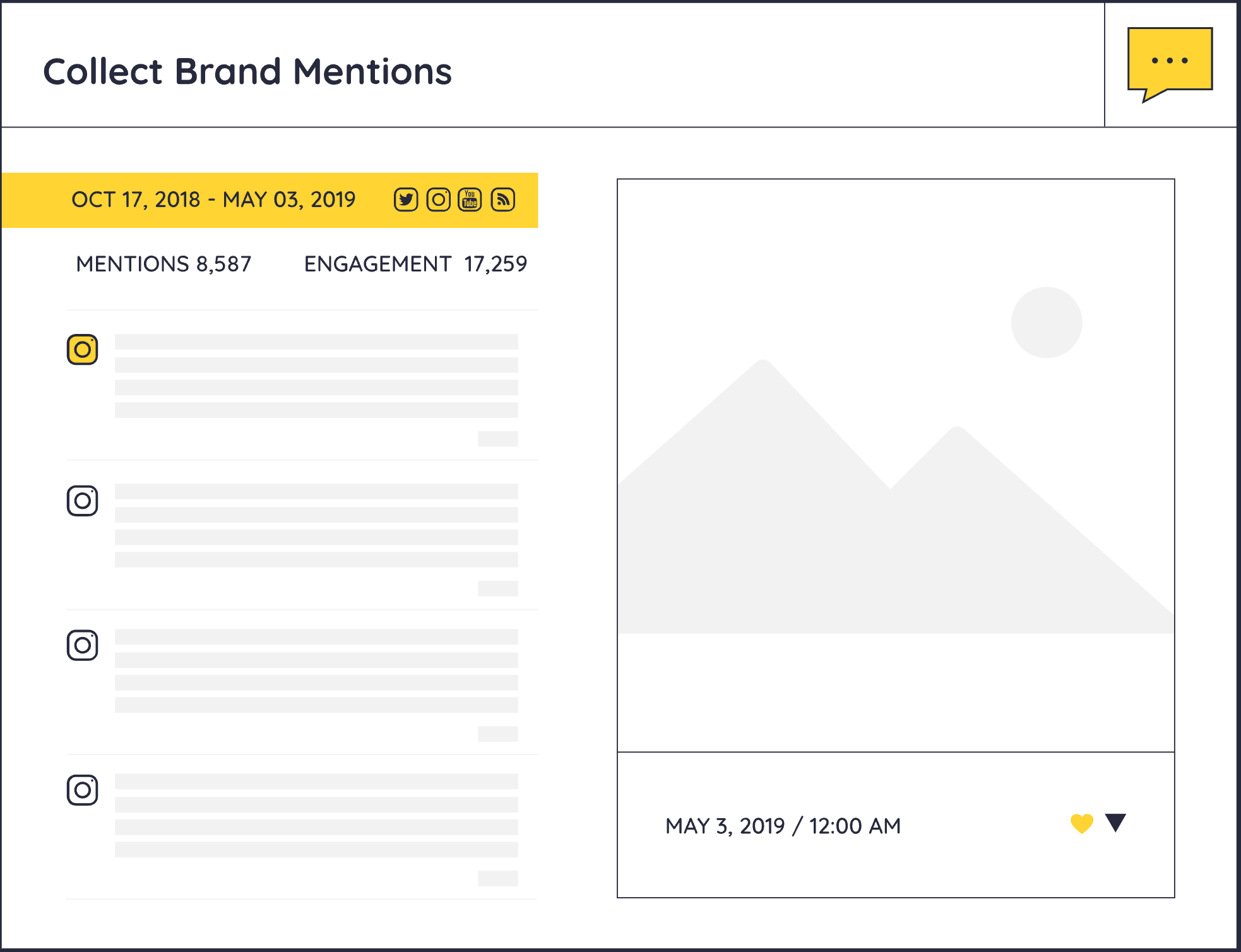
3. SparkToro
SparkToro is the ultimate tool for audience research. You can find topics your audience is discussing, discover relevant influencers, and see which websites your target customers hang out on. It has a free plan for up to 20 searches per month.
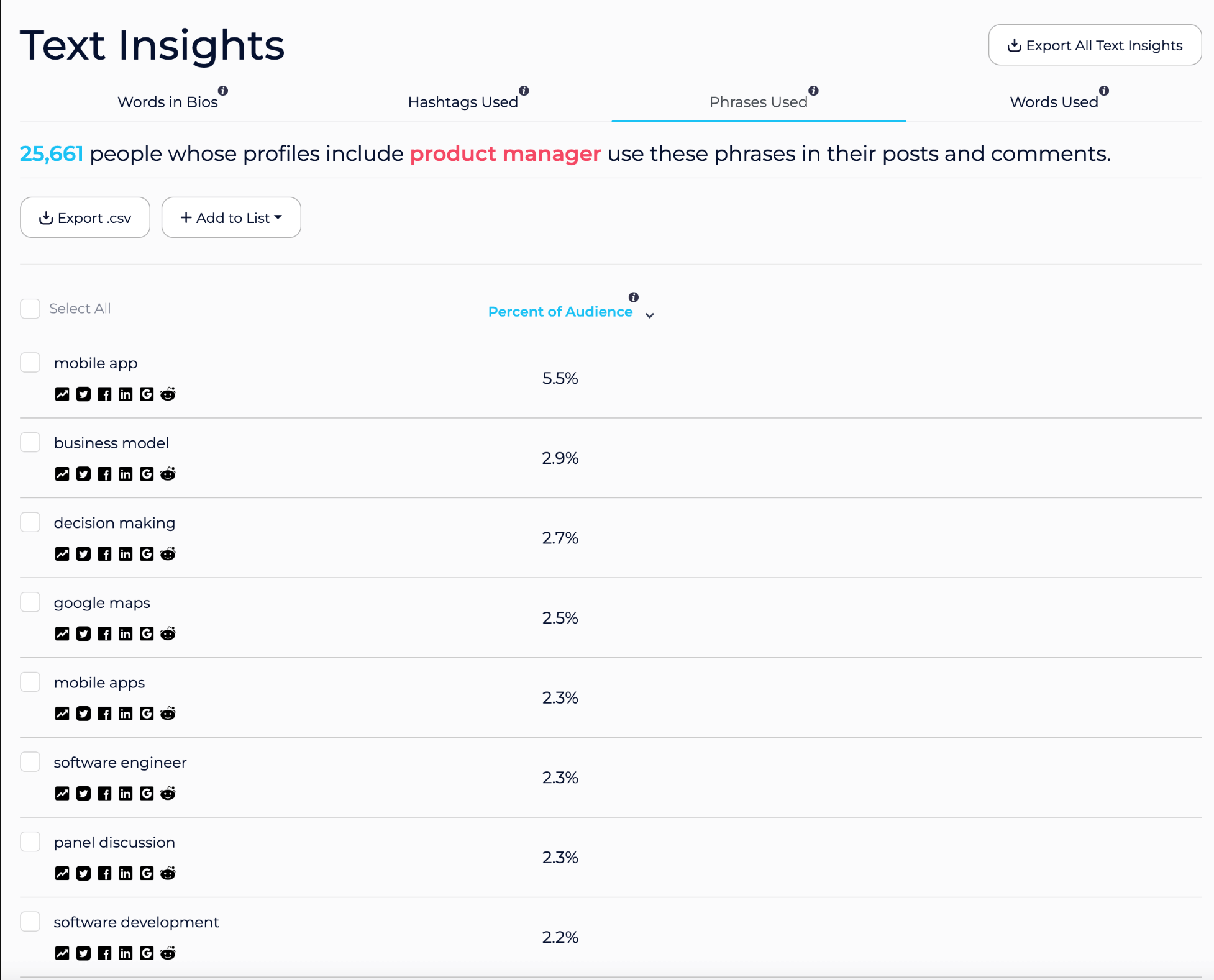
4. Answer The Public
Answer The Public is specifically useful for finding what your audience is searching for on Google and YouTube. You have to enter your topic in only one to two words, and the tool will offer various questions people have around that topic. You get three free searches every day.
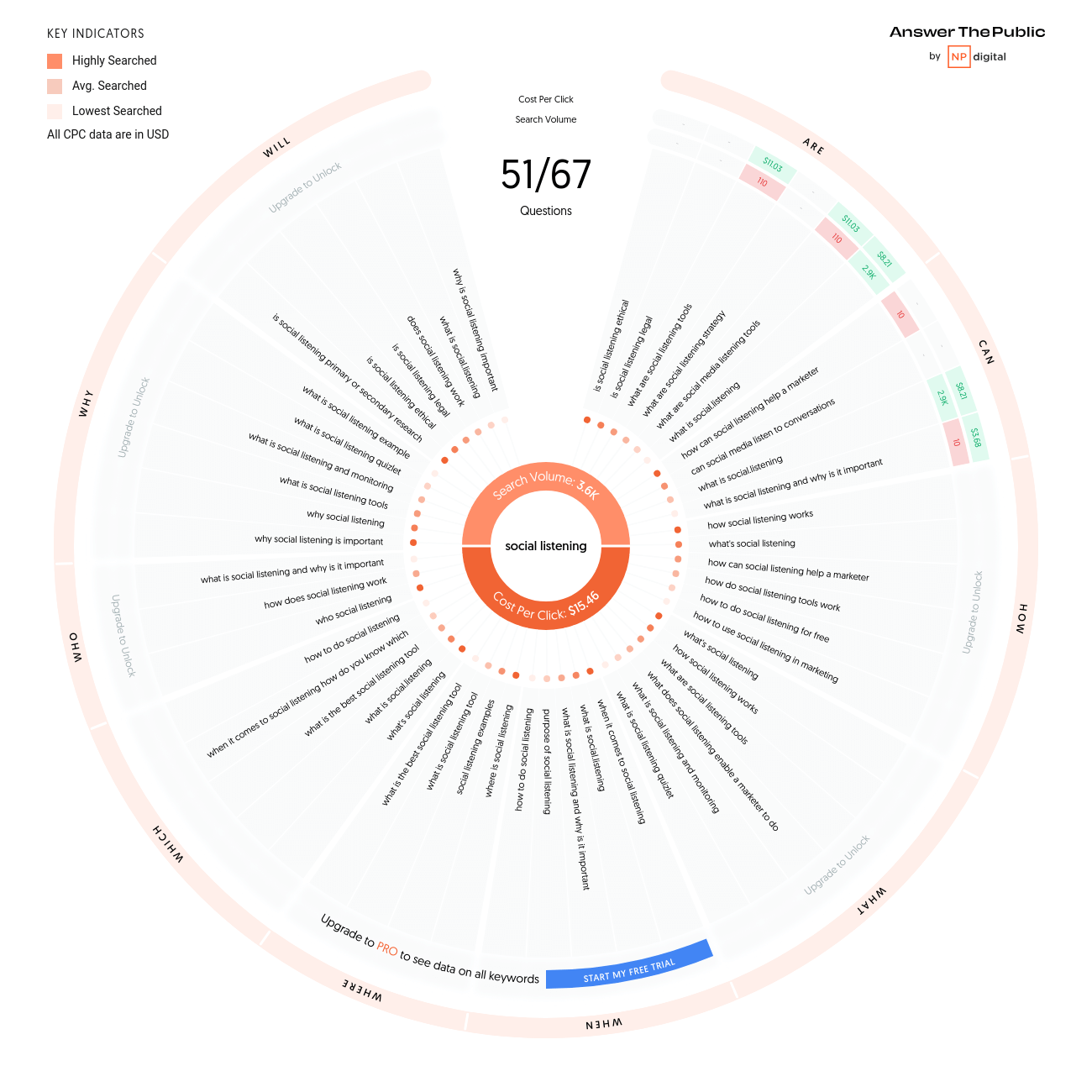
5. Talkwalker
Talkwalker is more than a social listening tool. It’s a complete consumer intelligence platform that provides insights into your buyers through its various features. It helps you discover trending topics, potential crises, and consumer pain points. Its pricing isn’t publicly available. But given its plethora of features, it might be pricey. Talkwalker is best to use when you have a full-fledged customer research initiative.
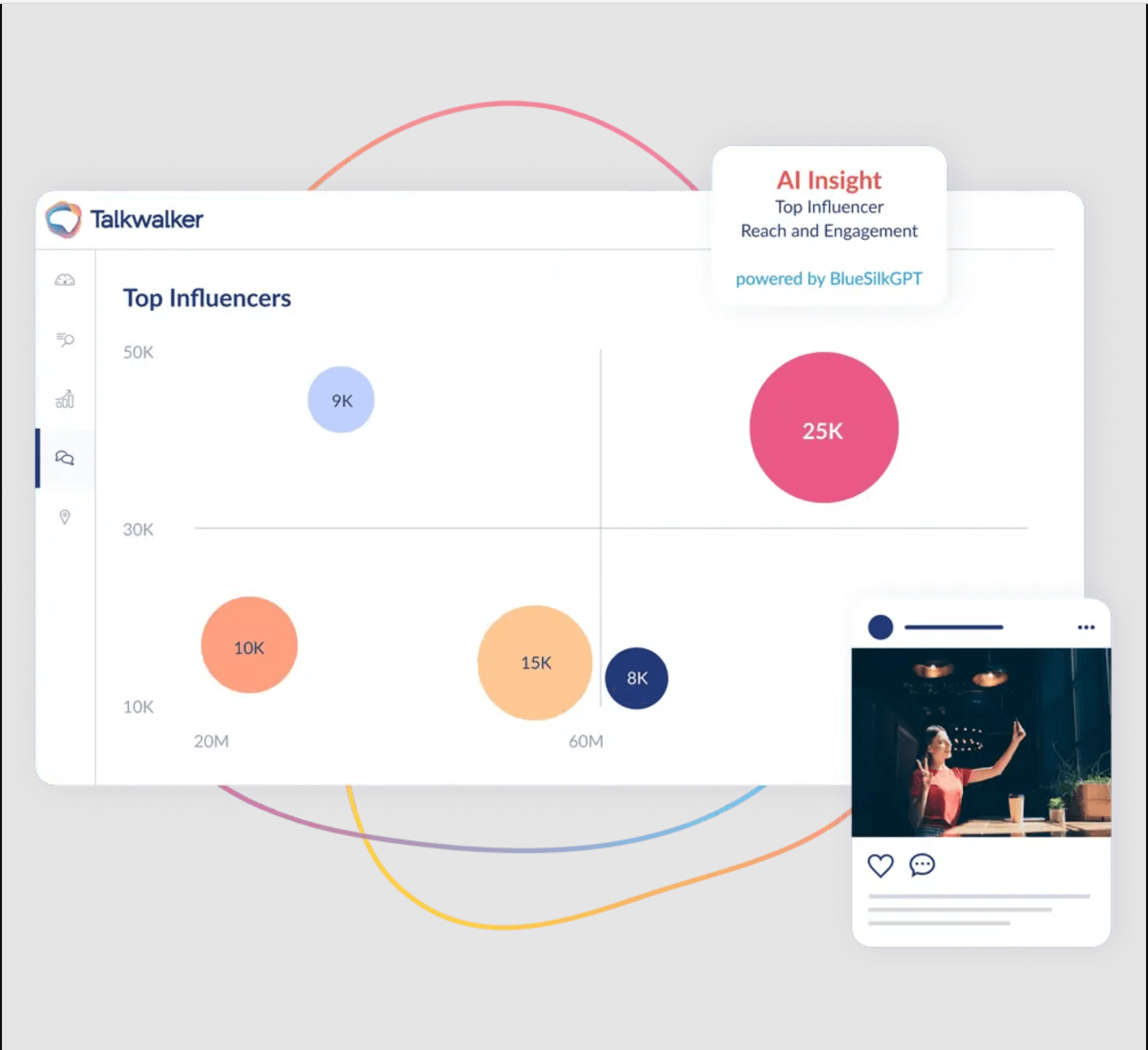
Social media listening tools are an essential toolkit for your social media management efforts. They make the process more efficient and easy to implement.
But remember: There are some things social listening tools just can’t do yet. For example, Gumroad and Beehiiv often retweet their customers’ achievements displayed via their products — even if the buyers don’t specifically tag them.
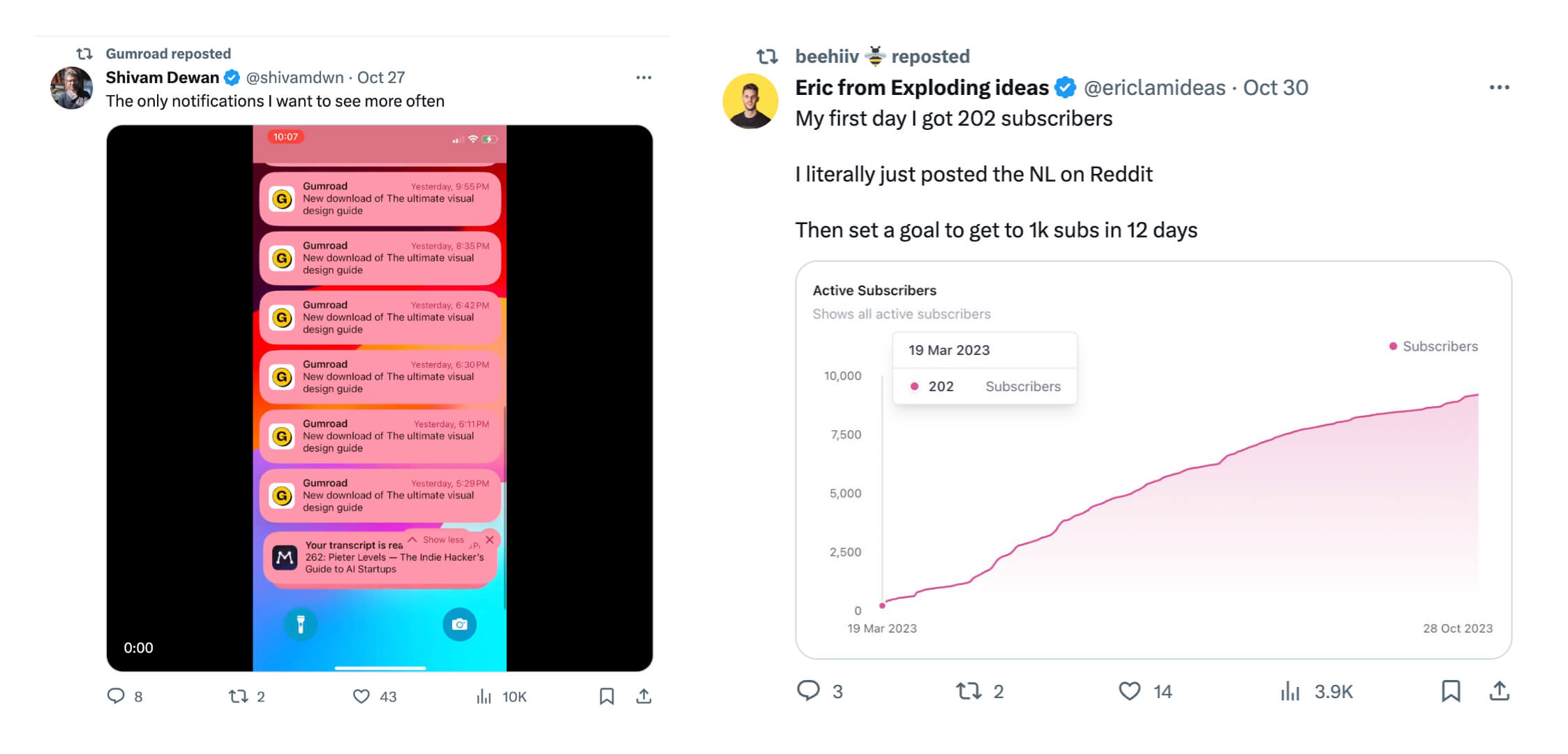
Spotting your product in the wild is difficult for social listening tools. You have to have some skin in the game and eyes on the road to catch these instances. The ideal social media strategy has part-automated and part-manual methods for social listening.
Step 3: Regularly measure the results and tweak your strategy to improve ROI
Social listening is futile if you’re taking a shot in the dark. You have to see if your arrow hit the mark. Remember those goals we set in step one? Set a timeline to achieve them and check your progress once the deadline arrives.
Let’s say your aim was to build brand awareness. You can check whether or not you were successful through various metrics and social media analytics:
- How many press mentions did your brand receive?
- How many thought leaders or influencers did you partner with?
- How many customers’ UTM codes showed they discovered you via social media channels?
Set these metrics in step one to make your goal more concrete. But hold the numbers lightly. Like any social media data, the actual effects of social listening on business are often hard to quantify.
An example: Someone might’ve read your brand’s name multiple times in articles, seen you pop up on social platforms, and witnessed influencers praising you. But they take action two months later (!) when they need your product or service — because you were top-of-mind. It’s impossible to attribute this to social listening efforts, even though it’s a major factor in play.
In the end, remember the ultimate goal of social listening is to understand customers better and help them at the right time.
Be a good listener to ace social listening
“Listening” is the crux of using social media to grow your business. Your customers are more vocal than ever about what they need and like. All you have to do is keep your ears open.
If it all looks too overwhelming, start by dedicating 30 minutes of your day to catch up on industry news and online conversations. And keep reading the Buffer blog — we have plenty of resources for small and large queries alike.
Start by reading how to make your social media marketing plan from scratch.





